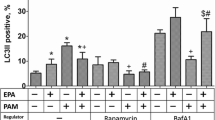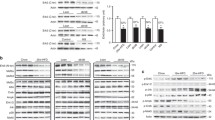Abstract
Purpose
Excessive fat intake induces obesity and causes cardiac injury. Intracellular degradation process involving destruction of long-lived proteins and organelles maintains homeostasis for cells under stress. The purpose of this study was to explore the relation of high-fat diet (HFD)-induced cardiac injury and intracellular degradation process with regard to autophagy and ER stress.
Methods and results
HFD feeding for 24 weeks induced hyperglycemia, hyperlipidemia, and cardiac hypertrophy in adult male C57BL/6 mice. In the heart, PARP cleavage, an indicator of apoptosis, levels of LC3-II and p62, indicators of autophagy, and CHOP, indicator of ER stress, were increased. A palmitate-treated cardiomyoblast (H9C2) cell culture was examined to explore how HFD induced myocardial injury. Excessive palmitate (400 μM) treatment induced apoptosis and increased the number of autophagosomes and acid vacuoles of H9C2 cells. Besides, it elevated the expression of LC3-II, p62, and PARP cleavage. Induction of autophagy by rapamycin ameliorated palmitate-induced apoptosis, while inhibition of autophagy by 3-methyladenine or LC3 siRNA exacerbated palmitate-induced apoptosis. Palmitate treatment also induced CHOP expression which is associated with ER stress.
Conclusion
HFD can cause cardiac injury by induction of apoptosis which is associated with autophagy dysregulation and ER stress. In addition, autophagy deficiency augments cardiac apoptosis, suggesting that autophagy serves as a pro-survival role in lipotoxic condition.




Similar content being viewed by others
References
Ren SY, Xu X (2015) Role of autophagy in metabolic syndrome-associated heart disease. Biochim Biophys Acta 1852:225–231. doi:10.1016/j.bbadis.2014.04.029
Feng YC, He D, Yao ZY, Klionsky DJ (2014) The machinery of macroautophagy. Cell Res 24:24–41. doi:10.1038/Cr.2013.168
Martinet W, Knaapen MW, Kockx MM, De Meyer GR (2007) Autophagy in cardiovascular disease. Trends Mol Med 13:482–491
Chen CY, Hsu HC, Lee BC, Lin HJ, Chen YH, Huang HC et al (2010) Exercise training improves cardiac function in infarcted rabbits: involvement of autophagic function and fatty acid utilization. Eur J Heart Fail 12:323–330. doi:10.1093/eurjhf/hfq028
Ceylan-Isik AF, Kandadi MR, Xu XH, Hua YN, Chicco AJ, Ren J et al (2013) Apelin administration ameliorates high fat diet-induced cardiac hypertrophy and contractile dysfunction. J Mol Cell Cardiol 63:4–13. doi:10.1016/j.yjmcc.2013.07.002
Hsu HC, Chen CY, Chiang CH, Chen MF (2014) Eicosapentaenoic acid attenuated oxidative stress-induced cardiomyoblast apoptosis by activating adaptive autophagy. Eur J Nutr 53:541–547. doi:10.1007/s00394-013-0562-2
Xu XM, Kobayashi S, Chen K, Timm D, Volden P, Huang Y et al (2013) Diminished autophagy limits cardiac injury in mouse models of type 1 diabetes. J Biol Chem 288:18077–18092. doi:10.1074/jbc.M113.474650
Kobayashi S, Liang Q (2015) Autophagy and mitophagy in diabetic cardiomyopathy. Biochim Biophys Acta 1852:252–261. doi:10.1016/j.bbadis.2014.05.020
Minamino T, Kitakaze M (2010) ER stress in cardiovascular disease. J Mol Cell Cardiol 48:1105–1110. doi:10.1016/j.yjmcc.2009.10.026
Yang LF, Hu N, Jiang SS, Zou YZ, Yang J, Xiong LZ et al (2014) Heavy metal scavenger metallothionein attenuates ER stress-induced myocardial contractile anomalies: role of autophagy. Toxicol Lett 225:333–341. doi:10.1016/j.toxlet.2013.12.024
Ceylan-Isik AF, Sreejayan N, Ren J (2011) Endoplasmic reticulum chaperon tauroursodeoxycholic acid alleviates obesity-induced myocardial contractile dysfunction. J Mol Cell Cardiol 50:107–116. doi:10.1016/j.yjmcc.2010.10.023
Chen CY, Liu CH, Tsai YC, Hsu HC, Chen MF (2013) ER stress, but not autophagy, was activated for cadioprotection during short-term receiving the high fat/sucrose diet. Eur Heart J 34(Suppl 1):693. doi:10.1093/eurheartj/eht309.P3883
Eng KE, Panas MD, Hedestam GBK, McInerney GM (2010) A novel quantitative flow cytometry-based assay for autophagy. Autophagy 6:634–641
Pattingre S, Tassa A, Qu XP, Garuti R, Liang XH, Mizushima N et al (2005) Bcl-2 antiapoptotic proteins inhibit Beclin 1-dependent autophagy. Cell 122:927–939. doi:10.1016/j.cell.2005.07.002
Levine B, Klionsky DJ (2004) Development by self-digestion: molecular mechanisms and biological functions of autophagy. Dev Cell 6:463–477
Hamacher-Brady A, Brady NR, Gottlieb RA (2006) Enhancing macroautophagy protects against ischemia/reperfusion injury in cardiac myocytes. J Biol Chem 281:29776–29787. doi:10.1074/jbc.M603783200
Wang Z, Cui M, Sun L, Jia Z, Bai Y, Ma K et al (2007) Angiopoietin-1 protects H9c2 cells from H2O2-induced apoptosis through AKT signaling. Biochem Biophys Res Commun 359:685–690
Lancel S, Montaigne D, Marechal X, Marciniak C, Hassoun SM, Decoster B et al (2012) Carbon monoxide improves cardiac function and mitochondrial population quality in a mouse model of metabolic syndrome. PLoS One 7:e41836. doi:10.1371/journal.pone.0041836
Cui MX, Yu H, Wang JL, Gao JJ, Li J (2013) Chronic caloric restriction and exercise improve metabolic conditions of dietary-induced obese mice in autophagy correlated manner without involving AMPK. J Diabetes Res 2013:852754. doi:10.1155/2013/852754
Knowles CJ, Cebova M, Pinz IM (2013) Palmitate diet-induced loss of cardiac caveolin-3: a novel mechanism for lipid-induced contractile dysfunction. PLoS One 8:e61369. doi:10.1371/journal.pone.0061369
Nobuhara M, Saotome M, Watanabe T, Urushida T, Katoh H, Satoh H et al (2013) Mitochondrial dysfunction caused by saturated fatty acid loading induces myocardial insulin-resistance in differentiated H9c2 myocytes: a novel ex vivo myocardial insulin-resistance model. Exp Cell Res 319:955–966. doi:10.1016/j.yexcr.2013.02.004
Chou IP, Lin YY, Ding ST, Chen CY (2014) Adiponectin receptor 1 enhances fatty acid metabolism and cell survival in palmitate-treated HepG2 cells through the PI3K/AKT pathway. Eur J Nutr 53:907–917. doi:10.1007/s00394-013-0594-7
Palomer X, Capdevila-Busquets E, Botteri G, Salvado L, Barroso E, Davidson MM et al (2014) PPAR beta/delta attenuates palmitate-induced endoplasmic reticulum stress and induces autophagic markers in human cardiac cells. Int J Cardiol 174:110–118. doi:10.1016/j.ijcard.2014.03.176
Alvarez-Guardia D, Palomer X, Coll T, Serrano L, Rodriguez-Calvo R, Davidson MM et al (2011) PPAR beta/delta activation blocks lipid-induced inflammatory pathways in mouse heart and human cardiac cells. Biochim Biophys Acta 1811:59–67. doi:10.1016/j.bbalip.2010.11.002
Leroy C, Tricot S, Lacour B, Grynberg A (2008) Protective effect of eicosapentaenoic acid on palmitate-induced apoptosis in neonatal cardiomyocytes. Biochim Biophys Acta 1781:685–693. doi:10.1016/j.bbalip.2008.07.009
Yang L, Zhao D, Ren J, Yang J (2015) Endoplasmic reticulum stress and protein quality control in diabetic cardiomyopathy. Biochim Biophys Acta 1852:209–218. doi:10.1016/j.bbadis.2014.05.006
Acknowledgments
This study was supported in part by Grant NSC 101-2313-B-002-030-MY3, NSC 101-2314-B-002-187-MY3, and MOST 103-2313-B-002-035 from the Ministry of Science and Technology, Taiwan. The authors are grateful to Miss Mai-Jun Lai and Miss Cian-Jyun Kao for their technical assistance.
Authors’ contributions
Hsu C. H. carried out the studies and data analyses and drafted the manuscript. Chen C. Y. conceived the study, participated in its design and coordination, and helped to draft the manuscript. Lee B. C. carried out the animal studies and data analyses. Chen M. F. obtained funding and supervised the study. All authors read and approved the final manuscript.
Author information
Authors and Affiliations
Corresponding author
Ethics declarations
Conflict of interest
None.
Rights and permissions
About this article
Cite this article
Hsu, HC., Chen, CY., Lee, BC. et al. High-fat diet induces cardiomyocyte apoptosis via the inhibition of autophagy. Eur J Nutr 55, 2245–2254 (2016). https://doi.org/10.1007/s00394-015-1034-7
Received:
Accepted:
Published:
Issue Date:
DOI: https://doi.org/10.1007/s00394-015-1034-7




